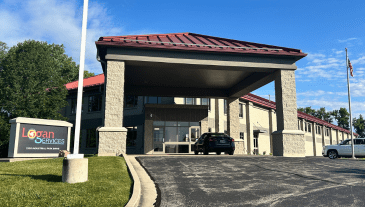A ductless mini-split air conditioner is a heating and cooling system that allows for zoned climate control. Unlike central HVAC units, mini-split systems do not require ductwork and are composed of an outdoor compressor that’s connected to one or multiple wall-mounted indoor units mounted in various areas of your home. The systems utilize refrigerant lines rather than ducts to channel conditioned air.
How Does a Ductless Air Conditioning System Work?
Understanding the basics of split AC technology can seem complicated at first, but to understand it, we can break it down into three main components:
The Outdoor Unit
This unit contains the compressor, condenser coil, and fan. The compressor pressurizes refrigerant gas, which is then passed to the condenser. As hot compressed gas gets cooled off and condensed by outdoor air, it turns into a high-pressure liquid.
The Indoor Unit
After going through the outdoor unit, the liquefied refrigerant passes through pipes into the wall-mounted indoor unit. This contains an evaporator coil and an additional blower fan. As the liquid refrigerant evaporates in the coil, it pulls heat out of the air inside your room, causing the evaporator to absorb heat energy. This process effectively cools your room with cool air.
The Thermostat
The thermostat mounted on your wall controls the temperature by telling the outdoor unit when to provide heating or cooling to the indoor unit. Thermostats can control one or multiple air handler units.
This refrigeration cycle between the indoor and outdoor unit is how ductless air conditioners work to efficiently heat or cool your spaces without the need for ductwork.
Benefits of Ductless Mini-Split AC Systems
There are many good reasons to consider installing ductless air conditioners:
Zoned Temperature Control
One of the biggest perks is having independent temperature control across different areas of your home. Units allow you to custom adjust temperatures exactly where the indoor units are placed.
Energy Efficient Cooling and Heating
Ductless systems tend to be more energy efficient than central forced-air HVACs. By eliminating duct losses, the units avoid wasting huge amounts of cooled or heated air through leaky ductwork.
Flexible Installation
The compact wall units can be installed in almost any indoor space since no ductwork is required. Their flexibility makes them perfect for heating or cooling additions like garages or attics that lack existing ducts.
Quiet Operation
With the outdoor compressor located outside rather than by your living spaces, ductless systems operate very quietly. This makes them an excellent cooling solution for bedrooms or home offices.
Cost Savings
While an initial investment, ductless mini split systems offer long-term savings from lower energy bills and affordable zone-by-zone installation compared to a whole home central air system.
Types of Ductless Mini-Split Air Conditioners
There are a few types of ductless systems categorized by the number of air handlers connected to the outdoor unit.
Single-Zone Systems
As their name suggests, single-zone mini splits have one indoor unit paired with one outdoor compressor to cool or heat one zone or room.
Multi-Zone Systems
For multi-zone systems, a single outdoor unit can support up to 8 indoor air handling units for broader whole-home cooling with independent climate zones.
Some units provide both heating and AC capabilities, while some models are cooling only or heating only, depending on your climate and needs. Many modern units come with advanced Smart/WiFi capabilities for controlling temperatures remotely via apps.
Best Practices for Mini-Split Placement
Proper placement of your indoor and outdoor units ensures optimal airflow and efficiency.
Outdoor Condensing Unit
This should be mounted in an open outdoor space like the side of your home, on brick/concrete pads, or on rooftop platforms for multi-story installations. The units perform best with at least 12 inches of clearance on all sides for ample airflow. Considerations should be made for avoiding excess sun/rain exposure.
Indoor Wall Units
Most manufacturers recommend installing high on the wall, about 8 to 12 inches from the ceiling. The units should have several inches of clearance from surrounding walls or obstructions that might block airflow. Also, take into account insulating air handler units in rooms with high ceilings.
Maintaining Your Ductless Mini-Split System
Proper maintenance keeps your system operating smoothly.
- Check and clean air filters every two weeks in high-dust environments or monthly otherwise. Clogged filters lower efficiency.
- Clear debris and overhanging branches around outdoor units. Any blockage of airflow reduces heating and cooling performance.
- Arrange professional annual tune-ups to clear condensate drains, sanitize evaporator coils, check refrigerant levels, and more.
Following manufacturer guidelines for cleaning and annual servicing will help ensure your ductless mini-split provides many years of energy-efficient indoor comfort and savings on energy bills. Contact a local HVAC technician for any questions or issues.
The Logan Difference
Family-owned since 1969, Logan A/C & Heat has set itself apart through our exceptional customer service, quality workmanship, and community involvement.
Our experienced technicians receive extensive training using a specialized checklist to ensure precise, efficient installations every time. We come fully prepared with all the needed parts to avoid any delays. Our installers walk you through operating your new system before leaving.
Taking the time to listen and address all questions, we want you to feel comfortable through transparent communication. We handle all warranty details, so you don’t have to.
Our roots here mean we love giving back, whether helping friends, neighbors, or local charities. The Logan Difference means we stand behind our work while caring about your comfort long after the job is done.
Frequently Asked Questions (FAQs)
How long do ductless mini-split systems last?
With proper maintenance like cleaning filters and annual checkups, the average lifespan of a ductless system is 15-20 years. High-quality brands with inverter-driven compressors can even last up to 25 years, outlasting traditional central air conditioners.
What problems occur with ductless AC systems?
Some common mini-split issues include refrigerant leaks, electrical problems like fuses/capacitors blowing, improper installation leading to drainage problems from condensation, WiFi/cable connectivity failures, fan motor failures, and thermostat malfunctions. Most problems can be quickly repaired by a skilled HVAC technician.
Why is my ductless AC not blowing cold air?
If your mini split fails to blow cold air, first check the thermostat temperature setting. If set low but still not cooling, there could be a low refrigerant charge from a leak, an electrical issue like a blown fuse, or the fan motors could have failed. An HVAC professional can diagnose and service the exact issue.
How often should you service a ductless air conditioner?
To keep your system running efficiently, it’s recommended to have a professional annual check-up done before each cooling/heating season to clean, sanitize, check refrigerant levels, inspect parts for wear, and make any necessary repairs.




















